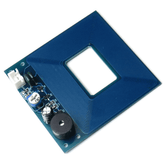Metal Detector: Working Principle, Major Components & DIY Guide
What is a metal detector?
A metal detector sensor is an electronic instrument which detects the presence of metal nearby. Metal detectors are useful for finding metal inclusions hidden within objects, or metal objects buried underground. They often consist of a handheld unit with a sensor probe which can be swept over the ground or other objects. If the sensor comes near a piece of metal this is indicated by a changing tone in the buzzer and an LED. The simplest form of a metal detector sensor consists of an oscillator producing an alternating current that passes through a coil producing an alternating magnetic field. If a piece of electrically conductive metal is close to the coil, eddy currents will be induced in the metal, and this produces a magnetic field of its own. If another coil is used to measure the magnetic field (acting as a magnetometer), the change in the magnetic field due to the metallic object can be detected.
In this blog, we will discuss the RC-A-354 metal detector which can search metal up to 3cm away.
Major Components of RC-A-354
- A copper coil of up to one-meter length which acts as an inductor.
- Two major capacitors of 100uf and 47uf.
- NE555 IC.
- Potentiometer of 5K
- Two diodes (IN4148)
- Buzzer
- LEDs
Connections
Simply, power it up by 5V DC supply.
Working of RC-A-354 Metal Detector Sensor
The 555 IC timer here acts as a square wave generator to generate pulses. In the circuit, there is an RLC circuit formed by a resistor, capacitor, and inductor. This RLC circuit is the metal detection part. A potentiometer is used to change the range of detection and it can detect up to 3cm. When electricity flows through the coil, a magnetic field is created all around it. When we move the detector over a metal object, the moving magnetic field creates electricity in the metal which in turn creates a magnetic field around the metal. It's this second magnetic field, around the metal, that the detector picks up. The metal detector sensor has a second coil of wire in its head (known as the receiver coil) that are connected to a circuit containing a speaker. As we move the detector about over the piece of metal, the magnetic field produced by the metal cuts through the coil. Now if we move a piece of metal through a magnetic field, you make electricity flow through it. So, as we move the detector over the metal, electricity flows through the receiver coil, making the speaker beep. When we power it up, the LED turns green in color and when it detects any metal the second LED gets turned on which is red in color and if it doesn’t detect any metal then it is off.
Explore more sensors from robocraze
Note: To detect, bring objects near to the coil not inside the coil otherwise it won’t detect.





1 comment
Thank you so much for giving good information about metal detector